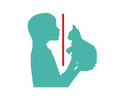
IGE结合FEL D 1

Purina 认为宠物和人在一起相处会更好。遗憾的是,对猫过敏的主人可能会被迫减少和猫相处的时间。

对猫过敏:对人类和猫均产生影响的常见问题。
过敏会损害过敏患者的生活质量,导致社交和日常活动出现问题,以及生产力和注意力下降。1,2
猫主人爱他们的宠物,大多数人认为它们是家庭的一部分;因此,过敏症专科医师基于指南提出的将猫从家里带走的建议经常会遇到阻力。2-4 过敏症会限制与猫共度时光的质量,进而影响人与动物之间的联系。

FEL D 1
观看视频,详细了解主要的猫过敏原
这个链接指向一个英文视频,没有[中文]翻译
对长期过敏的治疗有其局限性

对猫的过敏通常通过以下方法进行应对
- 限制或避免接触猫3
- 使用药物进行对症治疗9
- 通过接受免疫疗法进行脱敏3,10
- 清洁环境2,3,11
每一种方法都有局限性。
降低过敏原负荷:过敏应对的主要目标
过敏的人通常对一种以上的过敏原过敏,每个人都有一个过敏阈值,超过这个阈值他们就会出现过敏症状。12,13 只接触一种过敏原可能不会有问题,但同时接触多种过敏原可能导致累积效应(总过敏原负荷)超过该个体的过敏阈值并触发过敏反应。12 例如,对多种花粉过敏的人可能不会在只存在一种花粉时出现症状,但可能会在春季其他花粉的水平上升并增加过敏原负荷时出现症状。
如果可以通过避免或减少对一种或多种致敏过敏原的暴露来降低过敏原负荷,则过敏原的累积暴露水平可能会低于个体的阈值,从而改善或预防其过敏 症状。12 降低过敏原水平的努力会给过敏症患者带来不同程度的成功,具体取决于总过敏原负荷的水平是否降低至阈值以下以及该水平保持在阈值以下的时间。

图 1:累积过敏原负荷�对个体过敏阈值影响的可视化表示。在这种情况下,个体在家中暴露于多种过敏原。累积起来,这些暴露没有达到个体的阈值,因此不会产生过敏症状。然而,当某些季节性花粉达到高峰时,可能会超过个体的过敏阈值,并出现过敏症状。

Purina 在应对猫过敏方面的转变方法
一种降低 Fel d 1 过敏原负荷的新方法利用抗体 - 过敏原之间的相互作用,在猫产生 Fel d 1 之后但在其扩散至环境中之前将其中和。向猫喂食含有抗 Fel d 1 IgY 的鸡蛋制品成分的饮食,使猫唾液中的活性 Fel d 1(能够结合 IgE 以及在致敏个体中引发过敏反应的 Fel d 1)显著减少。这将最终降低环境中的活性 Fel d 1 水平,从而减轻过敏者的症状。14-16
相关内容
了解更多信息
1. Leynaert, B., Neukirch, C., Liard, R., Bousquet, J. & Neukirch, F. (2000). Quality of life in allergic rhinitis and asthma: A population-based study of young adults. American Journal of Respiratory and Critical Care Medicine, 162, 1391-1396.
2. Cosme-Blanco, W., Arce-Ayala, Y., Malinow, I. & Nazario, S. (2018). Primary and secondary environmental control measures for allergic diseases. In M. Mahmoudi (Ed.), Allergy and Asthma (pp. 1-36). Switzerland: Springer Nature. doi: 10.1007/978-3-319-58726-4_36-1
3. Dávila, I., Dominguez-Ortega, J., Navarro-Pulido, A., Alonso, A., Antolin-Amerigo, D., Gonzalez-Mancebo, E., Martin-Garcia, C., Nunez-Acevedo, B., Prior, N., …Torrecillas, M. (2018). Consensus document on dog and cat allergy. Allergy, 73(6), 1206-1222. doi: 10.1111/all.13391
4. Salo, P.M., Cohn, R.D., & Zeldin, D.C. (2018). Bedroom allergen exposure beyond house dust mites. Current Allergy and Asthma Reports, 18, 52. doi: 10.1007/s11882-018-0805-7
5. Bonnet, B., Messaoudi, K., Jacomet, F., Michaud, E. Fauquert, J.L., Caillaud, D., & Evrard, B. (2018). An update on molecular cat allergens: Fel d 1 and what else? Chapter 1: Fel d 1, the major cat allergen. Allergy, Asthma and Clinical Immunology, 14, 14. doi: 10.1186/s13223-018-0239-8
6. Butt, A., Rashid, D., & Lockey, R.F. (2012). Do hypoallergenic dogs and cats exist? Annals of Allergy, Asthma & Immunology, 108, 74-76. doi: 10.1016/j.anai.2011.12.005
7. Bastien, B., Gardner, C. & Satyaraj, E. Influence of time and phenotype on salivary Fel d 1 in domestic shorthair cats. In press, Journal of Feline Medicine and Surgery.
8. Kelly, S.M., Karsh, J., Marcelo, J., Boeckh, D., Stepner, N., Litt, D.,...Yang, W.H. (2018). Fel d 1 and Fel d4 levels in cat fur, saliva and urine. Journal of Allergy and Clinical Immunology, 142, 1990-1992.e3. doi: 10.1016/j.jaci.20107.033
9. Brown, L.C. & Slavin, R.G. (2005). Improving quality of life in patients with allergic rhinitis: The pharmacist’s role. Pharmacy Times. Retrieved from https://www.pharmacytimes.com/publications/issue/2005/2005-06/2005-06-9606 [accessed March 1, 2019] .
10. Mueller, R.S., Jensen-Jarolim, E., Roth-Walter, F., Marti, E., Janda, J., Seida, A.A. & DeBoer, D. (2018). Allergen immunotherapy in people, dogs, cats and horses – differences, similarities and research needs. Allergy, 73, 1989-1999. doi: 10.1111/all.13464
11. Björnsdottir, U.S., Jakobinudottir, S., Runarsdottir, V. & Juliusson S. (2003). The effect of reducing levels of cat allergen (Fel d 1) on clinical symptoms in patients with cat allergy. Annals of Allergy, Asthma and Immunology, 91, 189-194.
12. Wickman, M., Egmar, A.C., Emenius, G., Almqvist, C., Berglind, N., Larsson, P. & Van Hage-Hamsten, M. (1999). Fel d 1 and Can f1 in settled dust and airborne Fel d 1 in allergen avoidance day-care centres for atopic children in relation to number of pet-owners, ventilation and general cleaning. Clinical and Experimental Allergy, 29, 626-632.
13. Ciprandi, G., Alesina, R., Ariano, R., Aurnia, P., Borrelli, P., Cadario, G.,…Frati, F. (2008). Characteristics of patients with allergic polysensitization: the polismail study. European Annals of Allergy and Clinical Immunology, 40, 77-83.
14. Satyaraj, E., Li, Q., Sun, P. & Sherrill, S. Anti-Fel d 1 immunoglobulin Y antibody-containing egg ingredient lowers allergen levels in cat saliva. Submitted, Journal of Feline Medicine and Surgery.
15. Satyaraj, E., Gardner, C., Filipi, I., Cramer, K. & Sherrill, S. (2019). Reduction of active Fel d 1 from cats using an antiFel d 1 egg IgY antibody. Immunity, Inflammation & Disease. Advance online publication. doi: 10.1002/iid3.244
16. Wedner, H.J., Mantia, T., Satyaraj, E., Gardner, C., Al-Hammadi, N. & Sherrill, S. Feeding cats egg product with anti-Fel d 1 antibodies decreases environmental Fel d 1 and allergic response. Submitted, Journal of Allergy and Clinical Immunology.


